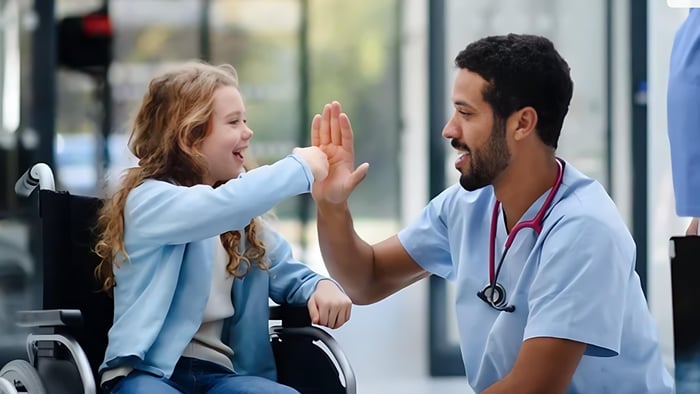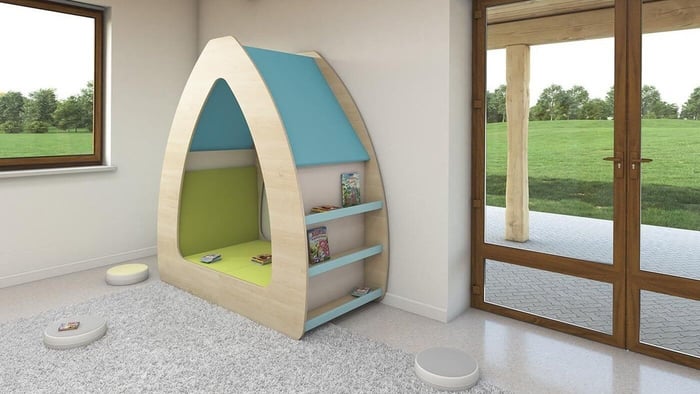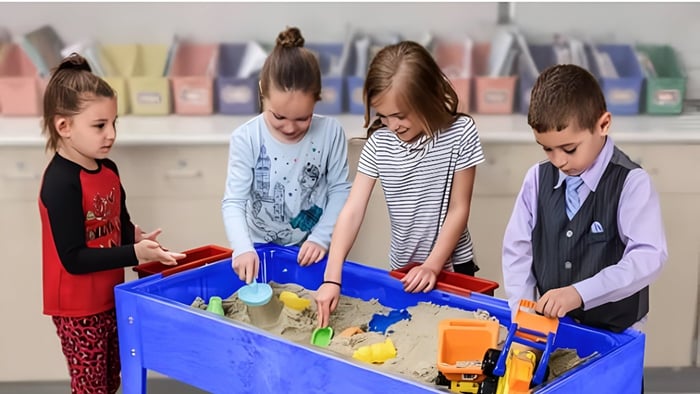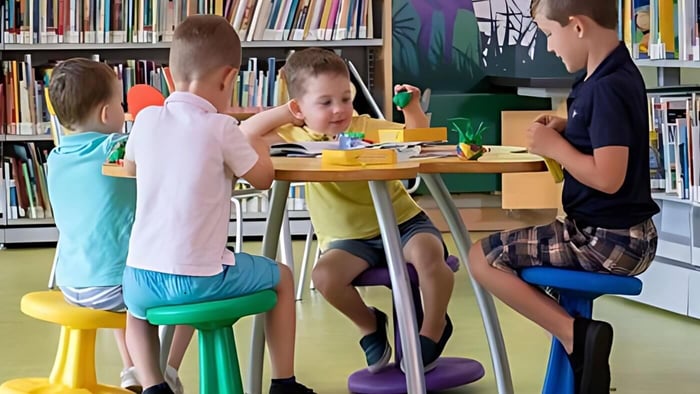
Special Education Classroom Setup Trends for 2026
Table of Contents
- Special education classrooms are getting a major makeover in 2026, with flexible seating, sensory-smart design, and AI-powered tools leading the charge. But one surprising trend is transforming how students with diverse abilities experience learning environments.
- Key Takeaways
- Flexible Layouts Gain Traction in Special Education Design
- Sensory Regulation Becomes a Design Priority
- Technology Integration Accelerates Accessibility
- Universal Design for Learning Principles Drive Inclusive Environments
- Visual Supports Boost Student Independence
- These Evidence-Based Trends Aim to Create More Effective Learning Outcomes for All Students
- FAQs
Special education classrooms are getting a major makeover in 2026, with flexible seating, sensory-smart design, and AI-powered tools leading the charge. But one surprising trend is transforming how students with diverse abilities experience learning environments.
Key Takeaways
- Flexible layouts with multiple seating options and wide pathways accommodate diverse learning preferences and mobility device access
- Sensory regulation features like calm-down zones, adjustable lighting, and visual boundaries help students self-manage emotions and focus
- AI-driven assistive technology personalizes learning experiences while speech-to-text software breaks down communication barriers
- Universal Design for Learning principles ensure every classroom element serves multiple learning styles and accessibility needs
- Evidence-based visual supports boost student independence through picture schedules and color-coded organization systems
Special education classrooms are experiencing a transformation that puts student needs at the center of design decisions. These emerging trends reflect a deeper understanding of how physical environments directly impact learning outcomes for students with diverse abilities and challenges.
Flexible Layouts Gain Traction in Special Education Design
The rigid desk-and-chair model is giving way to dynamic classroom configurations that adapt throughout the day. Adjustable-height desks, wobble stools, floor cushions, and standing workstations provide options that match individual sensory and physical needs. Students can choose seating that helps them focus, whether that means gentle movement through a stability ball or the secure feeling of a beanbag chair.
Wide, accessible pathways ensure students using wheelchairs, walkers, or other mobility devices can navigate independently. These layouts require doorways that meet ADA compliance standards and level, non-slip flooring that supports seamless transitions between activities.
Educators at Little People's Cove report that flexible arrangements help reduce behavioral challenges by giving students control over their learning environment. This approach transforms classrooms from static spaces into responsive environments that evolve with student needs throughout each day.
Active Learning Wobble Stool, 16"H
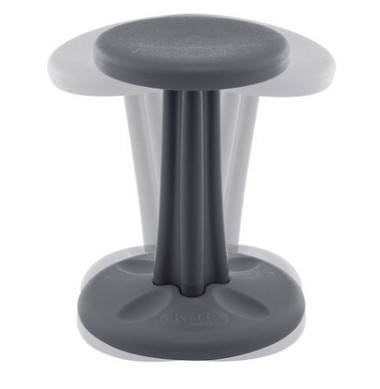
$88.55
Active Learning Wobble Stool, 16"H with it's rounded bottom creates a rocking motion which encourages active sitting. Increases learning retention, improves balance and memory. Perfect...… read more
Sensory Regulation Becomes a Design Priority
Students with autism, ADHD, and sensory processing differences require carefully designed environments that prevent overwhelming stimulation while providing necessary sensory input. Modern special education classrooms prioritize sensory-conscious design elements that support self-regulation and emotional stability.
1. Calm-Down Zones With Self-Regulation Tools
Designated retreat spaces offer students a voluntary escape when they feel overwhelmed. These areas feature weighted blankets, tactile cushions, fidget toys, and soft lighting that activate the nervous system's calming response. Research indicates these spaces reduce anxiety, aggressive behaviors, and repetitive actions when students have autonomous access to them.
Effective calm-down zones include visual supports guiding self-regulation steps, such as "find a comfortable spot, set a timer, choose a calming tool, return when ready." Trauma-informed approaches ensure these spaces feel safe rather than punitive, with clear sight lines for supervision that preserve student privacy.
2. Adjustable Lighting and Acoustic Controls
Soft, dimmable LED lighting replaces harsh fluorescent bulbs that can trigger sensory overload. Fairy lights, bubble lamps, and natural light options create soothing atmospheres that support focus and emotional regulation. Many classrooms now include individual lighting controls, allowing students to adjust brightness based on their current sensory needs.
Sound management involves acoustic panels, noise-dampening curtains, and white noise machines that reduce distracting auditory stimulation. Students can access noise-canceling headphones when needed, creating personalized sound environments that support concentration and reduce anxiety.
3. Visual Boundaries Define Activity Areas
Clear visual separation between classroom zones helps students understand expectations and transition smoothly between activities. Color-coded tape, area rugs, and strategic shelving placement create distinct spaces for reading, group work, independent study, and sensory breaks without requiring permanent walls.
These boundaries use muted colors and pastels rather than high-contrast patterns that might overstimulate sensitive students. Blue and green tones promote calmness, while neutral colors support overall well-being and focus.
Technology Integration Accelerates Accessibility
Assistive technology transforms how students with diverse abilities access curriculum content and demonstrate their understanding. Modern special education classrooms seamlessly integrate digital tools that remove communication barriers and personalize learning experiences.
Speech Recognition Software and AI-Driven Personalized Learning
AI-powered platforms that analyze individual learning patterns show promise for adjusting content difficulty, pacing, and presentation format in real-time. These systems recognize when students struggle with specific concepts and automatically provide alternative explanations, visual supports, or practice opportunities.
Voice-activated devices allow students with fine motor challenges to control their learning environment, access information, and complete assignments without physical barriers. Adaptive algorithms can align content with IEP goals while maintaining appropriate challenge levels that promote growth.
Text-to-Speech and Communication Devices
Students with reading difficulties, visual impairments, or communication challenges benefit from text-to-speech software or devices that converts written material into audio format. These tools provide multiple ways to access the same information, supporting understanding and independence.
Communication devices with symbol-based interfaces help non-verbal students participate in classroom discussions and express their needs. Modern apps generate speech from picture selections, enabling students to contribute meaningfully to group activities and social interactions.
Universal Design for Learning Principles Drive Inclusive Environments
UDL framework ensures classroom elements serve multiple learning styles and accessibility needs from the initial design phase. Rather than retrofitting accommodations, these environments anticipate diverse student requirements and build flexibility into every component.
1. Multiple Means of Engagement and Representation
Information presentation varies to match different processing strengths. Visual learners access graphic organizers and charts, while auditory learners benefit from recorded instructions and musical mnemonics. Kinesthetic learners engage through hands-on manipulatives and movement-based activities.
Content appears in multiple formats simultaneously, allowing students to choose their preferred access method. Digital materials include captions, audio descriptions, and interactive elements that transform passive consumption into active engagement.
2. Wide Pathways for Mobility Device Access
Classroom layouts prioritize navigation ease for students using wheelchairs, walkers, crutches, or other mobility aids. Furniture arrangement creates clear pathways between activity areas, storage spaces, and emergency exits without creating cramped or inaccessible zones.
Height-adjustable work surfaces accommodate students who remain in wheelchairs while providing standing options for those who benefit from position changes. Storage solutions place frequently used materials within reach of seated students while maintaining organization systems.
3. Collaborative Spaces Foster Team-Based Support
Designated areas support collaboration between general education teachers, special education specialists, related service providers, and paraprofessionals. Shared planning spaces and flexible meeting areas enable real-time consultation and coordinated support delivery.
These collaborative zones often include technology for virtual meetings with parents, outside specialists, or remote team members. Transparent communication systems ensure all team members stay informed about student progress and changing needs.
Ladybug Seating Set
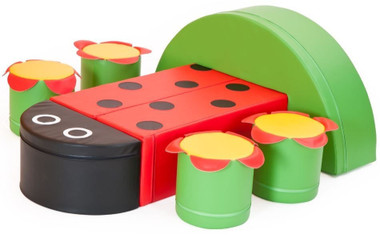
$1,309.41
This Ladybug is good luck! Sit together with friends at this creative and colorful table set. A beautiful form in a charming version of a...… read more
Visual Supports Boost Student Independence
Evidence-based visual support systems help students navigate classroom routines, understand expectations, and complete tasks with minimal adult assistance. These tools prove effective across age groups and disability categories, from preschool through high school settings.
Picture-Based Schedules and Routines
Daily schedules combine photographs, illustrations, and written words to communicate timing and sequence information. Students can reference these supports independently, reducing anxiety about transitions and increasing participation in classroom activities.
Visual task analyses break complex activities into manageable steps with clear illustrations. Students follow picture sequences to complete multi-step assignments, self-care routines, or classroom jobs, building confidence and independence skills that transfer to other environments.
Color-Coded Organization Systems
Consistent color schemes help students locate materials, understand categorization systems, and maintain organized workspaces. Subject-specific colors for folders, bins, and work areas create visual logic that supports memory and reduces confusion during transitions.
Personal organization tools like color-coded calendars, assignment trackers, and supply containers teach organizational skills while accommodating executive functioning challenges. Students develop systems they can replicate in future educational and employment settings.
These Evidence-Based Trends Aim to Create More Effective Learning Outcomes for All Students
The classroom design trends emerging in 2026 reflect years of research demonstrating how physical environments directly impact student engagement, behavior, and academic achievement. Research suggests that students in well-designed special education classrooms may show increased focus, reduced anxiety, and improved social interactions compared to traditional classroom arrangements.
These evidence-based approaches recognize that effective special education serves diverse learners through proactive environmental design rather than reactive accommodation. When classrooms anticipate student needs through flexible layouts, sensory supports, assistive technology, and visual systems, all students benefit from increased accessibility and engagement opportunities.
The investment in thoughtful classroom design pays dividends in student independence, academic progress, and preparation for post-secondary success. Schools implementing these trends report improved outcomes not just for students with disabilities, but for entire learning communities that benefit from inclusive, responsive environments.
Learn how Little People's Cove creates supportive learning environments that help every child reach their full potential through evidence-based classroom design and individualized educational approaches.
FAQs
What assistive technologies should be prioritized when setting up a special needs classroom?
Prioritize assistive technologies that support communication, accessibility, and sensory regulation. Key tools include AAC devices, screen readers, adaptive keyboards, noise-canceling headphones, and visual scheduling apps. These technologies ensure students can communicate effectively, stay engaged, and access learning with greater independence.
How do flexible furnishings and zoning support neurodiverse and special needs students?
Flexible furnishings and zoning help neurodiverse and special needs students by allowing them to choose seating and spaces that match their sensory and learning needs, reducing overwhelm and increasing focus. Clearly defined zones—such as quiet areas, sensory corners, and collaborative spaces—provide structure and predictability. Together, these elements create a more adaptive, comfortable environment that supports regulation and engagement.
What’s the role of sensory retreats or “calm-down areas” in classroom layouts?
Sensory retreats or “calm-down areas” provide a controlled, low-stimulation space where students can regulate emotions, reduce sensory overload, and regain focus. These areas help prevent escalation by giving students a safe, predictable place to decompress. When integrated into the classroom layout, they support self-regulation, emotional safety, and smoother transitions back to learning.

